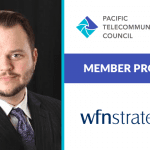
Swarmio CEO foresees a new world of cloud gaming. Service providers might see comeback roles too.
If customer needs determine services, network architectures may determine futures, at least for the providers of those services. If this is the case, look out for an epic battle between content players and telcos in the emerging world of edge clouds.
Vijai Karthigesu wants to be part of this battle. Mr. Karthigesu, a serial entrepreneur based in Toronto, founded Swarmio, his third start-up, as a focused edge player. He says he is convinced about what is at stake, and what will happen. “I believe whoever owns the edge, owns everything. The future is at the edge. Everything is going to be delivered from the cloud. It is an open question [who controls this world]: Google, Amazon, and the other content players, or telcos.”
With a track record in Internet architecture builds and VoIP ventures behind him, it was a relatively easy move toward the emerging big story in networking: edge architectures. A Canadian government-funded research program, with university partners, showed possibilities in network architecture engine improvements for high-performance markets. The Swarmio focus, he says, sprang from this and was founded to develop this expertise, and build edge clouds for what is likely to be an extremely demanding, but profitable, segment: gaming and eSports.
On the Edge?
The combination of edge, telcos, and eSports is an intriguing mix of focus, capability, market demand, and explosive technology combinations. The user base is certainly significant and sophisticated. An estimated 2.4 billion gamers exist globally, and the market is set to grow substantially. A rapid evolution to a cloud-based, gaming-as-a-service opportunity, moving from consoles to clouds is predicted by many commentators. More impetus will come from 5G, more demand from VR and AR roadmaps. Big content players have launched major initiatives: Google Stadia, Amazon Twitch, Microsoft xCloud, and Apple Arcade.
The momentum seems unstoppable. But who will benefit, and in what ecosystem? To answer, Mr. Karthigesu reaches across network history. “Telecom operators used to be king of the value chain,” he says. “But slowly they ‘lost’ everything [as the rest of the industry developed]: movies to Netflix, music to Spotify, voice to Skype and WhatsApp, and so on. Now, many are basically providing just a dumb pipe.” Even here, they face pressures, he contends, as content players frequently call the shots over the delivery and investment for services that telcos formerly owned. Telco networks, unlike data centers, he suggests, have seen relatively little innovation in nearly two decades. Meanwhile, globally, telco revenues are stagnating, while operational costs are effectively increasing due to investment demands.
However, he argues, they can still prosper if they adopt edge strategy because they still retain critical strengths. He explains: “In the 5G era we can ask: who is really closer to the users? The answer is the telco. Every gamer is a customer of a telco, the last mile connection. The first stop for any user is the telco. If we want to have [network architecture] closer to the user, it would be the telco edge.”
Next Step: The Ultimate Experience
He says strategic conversations with telcos around what he calls “the ultimate edge” strategy have resonated “very well.” In this world, edge computing would stream real-time applications such as multiplayer gaming in sophisticated, rendered worlds at 4K, he says. “This [represents] a huge latency issue. You need to have high-performance data centers at the edge and latencies of less than 10ms to support the demand.”
At the same time, benefits flow too in this new model. Users will enjoy improved experiences and arguably more access as new, low cost, low specification devices in a wide variety of formats come on stream, a scenario he calls “beautiful.” Geofenced edge clouds, he suggests, would also support data sovereignty and privacy demands.
The technology wrap-around mix is persuasive but also formidable. The emerging demand will force changes in network architectures and the underlying business models themselves, and he argues telcos already have last mile fiber and are building 5G, but edge cloud will give “a complete proposition.” As a result, the telco will offer a platform that includes “a connectivity layer and a compute layer that will work seamlessly with a centralized cloud.” It will provide “the ultimate experience” for users, he contends.
This new edge world could also get very complicated. “I still believe that edge computing needs to be tailored to specific needs,” he says. “Edge computing for IIoT, as an example, is going to have a completely different architecture from edge computing for gaming. There are going to be multiple, different edge architectures.”
Across all markets, this will be hotly contested between OTT players, data centers, and service providers. “The major data center people, the big players, want to own the telco cloud as well. But the edge cloud is an opportunity for telcos to be meaningful. With 5G, everything is going to be data, there is going to be no real voice network anymore. If the telcos do not step up and force themselves into the new value chain, the big players will start owning the edge as well.” Strategically, he says, this will be “a huge issue” for them.
Can telcos make headway? He says times and attitudes may be changing. “I have a feeling in talking to the telcos that they [now] see [the issue], and 5G [is providing an opportunity] to rethink their model,” he suggests. The new model could go beyond technology into offering marketing channels and resolving established credibility, accountability, and branding issues that some eSports activities have. “For the gaming industry, telcos have a lot to offer, especially in the eSports world,” he says. “Telcos could become critical pieces of the value chain for the gaming industry.”
The Road Ahead
Swarmio, he says, will target telco partnerships particularly in Asia and Latin America. He explains: “There are a billion gamers in Asia, [but] these regions are currently underserved. Our short-term focus is to get the telecom operators in Asia [on board] and we need just one or two key players in each region. We would like to build the largest edge computing platform for the gaming industry. That will bring a global platform for the gaming industry.”
Meanwhile, the cloud gaming roadmap would see servers moving to the edge to prepare for new cloud services, continued use of existing high performance terminals and smartphones, followed by the migration of real-time applications that need to be close to users from the cloud to the edge. Edge-friendly applications will be developed, although he acknowledges moving some present applications to the cloud could be challenging for the industry.
Getting Swarmio off the ground has meant rapid-fire innovation, and for him, it carries a wider message. “I am a big proponent of an open and flat company structure. I am a firm believer that the traditional corporate structure is not going to work in the future. People here work anywhere or anytime, with a focus on delivery.”
He continues: “My build strategy is to look for passionate people, people who want to make a change. My personal vision is to eradicate the inefficiencies in the world that we see around us. If I can do something here, I have made the world a little wiser.”







